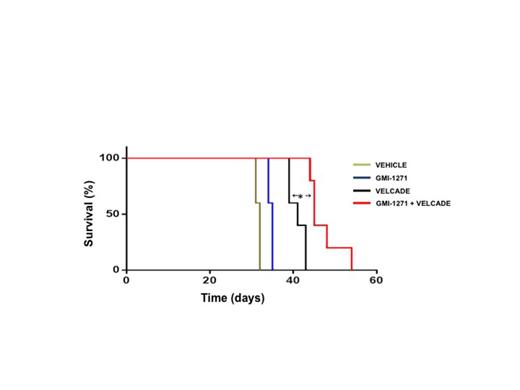Abstract
Introduction
Selectins and their ligands play an important role in the adhesion and trafficking of multiple myeloma (MM) cells. While PSGL-1 is strongly expressed by MM cells, E-selectin binding is seen in a small minority only and its contribution to MM cell trafficking is unclear. As E-selectin is constitutively expressed by BM endothelial cells it may play a critical role in the BM homing and retention of MM cells. We wished to determine (1) if MM cells express functional E-selectin ligands (2) whether hypoxia enhances E-selectin ligand positivity (3) the potential of the E-selectin inhibitor GMI-1271 to prolong survival in a murine model of MM minimal residual disease (4) the ability to identify patients most likely to benefit from E-selectin inhibition.
Methods
To detect E-selectin ligands MM cell lines were stained with an antibody to HECA452, which indicates reactivity with sialofucosylated glycoforms of PSGL-1 and CD44, which can bind E-selectin. To test the effect of hypoxia, MM cells were maintained in either 1% O2 or normoxia at 37¡C for 5 days and then stained with HECA452. MM cells were sorted into E-selectin ligand positive and negative populations based on HECA452 staining. We evaluated rolling of MM cells on E-selectin +/- 10 µM GMI-1271 for 1 h at 37¡C, following which 50 µl of cell suspension were loaded onto a channel of a microfluidic chip (Cellix) pre-coated with 30 µg/ml of recombinant E-Selectin (Peprotech). Cells were perfused into the channel at 0.5 Dyne/cm2 using Mirus Evo Nanopump (Cellix). After 2 min of perfusion, images were acquired at 5 different positions of the channel using an AX10 Vert.A1 microscope (Zeiss) equipped with aQImaging QIClickª digital CCD camera. Thirty frames were acquired at 5 different positions with 0.5 sec between each frame. Each sample was assayed in triplicate. To evaluate in-vivo activity of GMI-1271, SCID-beige mice were injected with luciferase-expressing MM1S cells. Seventy two hours after inoculation, mice were divided into cohorts treated with vehicle, GMI-1271 (40mg/kg bid), bortezomib (0.75 mg/kg IP weekly for 4 weeks), or a combination of GMI-1271 and bortezomib. Tumor burden was determined by bioluminescence imaging and animals were followed for survival. We evaluated gene expression levels of 2 genes involved in selectin ligand expression, the sialyltransferase ST3GAL6 and FUCA1 (fucosidase), which we have previously shown to be important in MM prognosis, in the context of ISS and FISH in the MRCIX dataset. Specifically, we analyzed the interaction of high ST3GAL6 and low FUCA1 with ISS/FISH risk, where patients are considered high risk if ISS=3 along with 17pdel or t(4;14).
Results
Twelve percent (12%) of MM1S and 15.8% of RPMI8226 cells were HECA452 positive. We consistently observed rolling of sorted HECA452 positive RPMI8226 and MM1S cells on E-selectin with absence of rolling in HECA452 negative fraction. Treatment with GMI-1271 completely inhibited rolling on E-selectin (100% inhibition). Prolonged exposure of RPMI8226 cells to hypoxia resulted in a significant increase in HECA452 positive cells (38.8% versus 25.2%, P=0.0215), consistent with our previous observation that hypoxia upregulates ST3GAL6. The survival of mice treated with either GMI-1271 alone or bortezomib alone was significantly greater than vehicle treated control mice. GMI-1271 in combination with bortezomib treatment however, resulted in the longest survival and significantly longer than treatment with bortezomib alone (p=0.0025). The high ST3GAL6/low FUCA1 signature was overrepresented in high risk compared to low risk [39% (6% of whole population) .v. 13.9% p=0.01] patients and conferred poor prognosis with a median survival of 10 months versus 33 months in the remaining 61% of high-risk patients. On multivariate analysis this pattern was independent of ISS/FISH for OS (p=0.013).
Conclusions
A small fraction of MM cells express functional E-selectin ligands, which may be higher in the hypoxic BM niche. The binding of these cells to E-selectin is blocked by GMI-1271 and GMI-1271 significantly enhances the activity of bortezomib in vivo. These data indicate the importance of E-selectin ligand expressing MM cells in homing and engraftment and provide a rationale for targeting E-selectin in MM. Furthermore, high ST3GAL6 + low FUCA1 identifies a subgroup of patients with high risk ISS/FISH with particularly poor outcome who may benefit from E-selectin inhibition.
Magnani:GlycoMimetics Inc.: Employment, Equity Ownership, Membership on an entity's Board of Directors or advisory committees. Ghobrial:GlycoMimetics: Consultancy, Research Funding. O'Dwyer:GlycoMimetics: Consultancy, Research Funding.
Author notes
Asterisk with author names denotes non-ASH members.


This feature is available to Subscribers Only
Sign In or Create an Account Close Modal